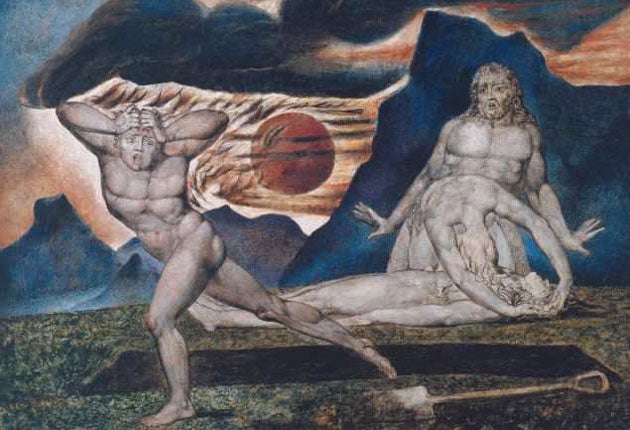Recreated: the exhibition that broke William Blake

When William Blake began orchestrating his first solo exhibition in London in March 1809, showcasing what he thought were his most important works of art, he hoped the world would instantly hail him as a British Raphael or Michelangelo.
But it was a career turning point of a very different kind. Blake's art show, at his brother's shop in Soho, was a critical flop which precipitated a crisis of confidence. Only one critic turned up to give it a stinking review and even his friends were baffled by the 16 works on show. The opening night was such a blow to Blake's ego that he retreated from public life and became deeply embittered by the state of the art world.
Now, his most ambitious attempt to create a public reputation as a painter will be re-enacted by Tate Britain.
The show that starts in April will reunite nine of the surviving works, with spaces left for missing works, including one three-metre high work called Ancient Britons featuring scenes from mythology and ancient British history that disappeared from public records in the 19th century. Martin Myrone, curator of William Blake: The 1809 Exhibition, said the impact on Blake's self-confidence was devastating. "In putting on this show he wanted to present himself as a painter like the great Renaissance fresco painters, with ambitions to paint large scale. He imagined that some of these small works would eventually be reproduced as 100ft-high images in palaces and on altar pieces in cathedrals.
Mr Myrone said the poor response marked a dramatic turning point in Blake's career. "The works were unlike other paintings of the age, they were so original and strange that they were hard to understand. After 1809, he retreated into himself. He never again tried to create a public reputation."
He said the reason the gallery chose to re-enact this point in Blake's career was because it gave such a direct insight into what he was thinking. The only review to be published the following day was in The Examiner, on 17 March, disparagingly equating the works with the "outpourings of a madman". The article read: "If... the sane part of the people of England required fresh proofs of the alarming increase of the efforts of insanity, they will be too well convinced from its having been spread into the hitherto sober regions of art."
While Blake was known as a poet, he had trained in life drawing at the Royal Academy and had been an apprentice to the engraver, James Basire. While he developed a trade in engravings, his ambition was to establish a reputation as a fine artist.
It was not until half a century after his death that critical appreciation of his work was revised. Today, his poetry and art is considered to be seminal in the history of the Romantic period.
The free exhibition includes works that are regarded as his most "visionary", such as The Spiritual Form of Pitt Guiding Behemoth and The Spiritual Form of Nelson Guiding Leviathan. Works have been borrowed from the Victoria & Albert Museum, British Museum, Fitzwilliam Museum and Southampton Art Gallery.
The visionary
Born in 1757, William Blake, poet, painter and engraver, was one of the geniuses of English Romanticism. As the poet Ezra Pound once wrote about his own creation Hugh Selwyn Mauberley, Blake was wholly "out of key with his times", and it was not until decades after his death that his achievements began to be appreciated.
Although Blake was apprenticed early to an engraver, his visionary works seems to be spun out of his own inner worlds. He parleyed with angels and devils on a regular basis, it was said. Many madmen have done the like. But only Blake has been able to represent, and bring to earth, those angelic and demonic forces in the way that he did. His figures were both extravagant and subtle.
His colours, glowing, unearthly minglings of pink and orange, make you think that he must at least have stared directly into the face of the sun and sucked out its essence as one greedily sucks out the juice of an orange.
This exhibition, we are promised, will be a reconstruction of Blake's last show – which was treated with disdain and incomprehension by those who were utterly bewildered by Blake's talent. There is nothing unusual about this. Posterity is often the better judge of genius. Sometimes it takes time to catch up.
Michael Glover
Join our commenting forum
Join thought-provoking conversations, follow other Independent readers and see their replies
Comments